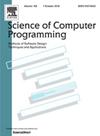Vamos:尽力而为的第三方监控中间件
IF 1.4
4区 计算机科学
Q3 COMPUTER SCIENCE, SOFTWARE ENGINEERING
引用次数: 0
摘要
随着软件复杂性和关键性的逐年增加,运行时监控的重要性也随之增加。第三方监控和尽力监控是运行时监控中特别有价值的领域,但尚未得到充分开发。在这里,第三方监控指的是在对被监控软件了解有限的情况下进行监控(因为该软件是由第三方开发的)。竭尽全力的监控能与被监控软件保持同步,但代价是在无法与被监控软件保持同步的情况下,可能做出不精确的判断。大多数现有的监控框架都不支持第三方监控和尽力监控的结合,因为它们要么要求完全访问被监控的代码,要么要求能够处理所有可观察到的事件,或者两者兼而有之。Vamos 在设计上明确支持第三方和尽力而为的方案。Vamos 的设计目标是:(i) 高效(以较低的开销跟踪事件);(ii) 灵活(能够监控各种不同的事件通道,并连接到各种监控器);(iii) 易于使用。为了实现其目标,Vamos 将事件代理和事件识别系统的各个方面与流处理系统的各个方面结合起来。结果表明,Vamos 能够编写有用而高效的监控器,并简化了从头开始建立监控系统的关键环节。本文章由计算机程序翻译,如有差异,请以英文原文为准。
Vamos: Middleware for best-effort third-party monitoring
As the complexity and criticality of software increase every year, so does the importance of runtime monitoring. Third-party and best-effort monitoring are especially valuable, yet under-explored areas of runtime monitoring. In this context, third-party monitoring means monitoring with a limited knowledge of the monitored software (as it has been developed by a third party). Best-effort monitoring keeps pace with the monitored software at the cost of possibly imprecise verdicts when keeping up with the monitored software would not be feasible. Most existing monitoring frameworks do not support the combination of third-party and best-effort monitoring because they either require the full access to the monitored code or the ability to process all observable events, or both.
We present a middleware framework, Vamos, for the runtime monitoring of software. Vamos is explicitly designed to support third-party and best-effort scenarios. The design goals of Vamos are (i) efficiency (tracing events with low overhead), (ii) flexibility (the ability to monitor a variety of different event channels, and to connect to a wide range of monitors), and (iii) ease-of-use. To achieve its goals, Vamos combines aspects of event broker and event recognition systems with aspects of stream processing systems.
We implemented a prototype toolchain for Vamos and conducted a set of experiments demonstrating the usability of the scheme. The results indicate that Vamos enables writing useful yet efficient monitors, and simplifies key aspects of setting up a monitoring system from scratch.
求助全文
通过发布文献求助,成功后即可免费获取论文全文。
去求助
来源期刊

Science of Computer Programming
工程技术-计算机:软件工程
CiteScore
3.80
自引率
0.00%
发文量
76
审稿时长
67 days
期刊介绍:
Science of Computer Programming is dedicated to the distribution of research results in the areas of software systems development, use and maintenance, including the software aspects of hardware design.
The journal has a wide scope ranging from the many facets of methodological foundations to the details of technical issues andthe aspects of industrial practice.
The subjects of interest to SCP cover the entire spectrum of methods for the entire life cycle of software systems, including
• Requirements, specification, design, validation, verification, coding, testing, maintenance, metrics and renovation of software;
• Design, implementation and evaluation of programming languages;
• Programming environments, development tools, visualisation and animation;
• Management of the development process;
• Human factors in software, software for social interaction, software for social computing;
• Cyber physical systems, and software for the interaction between the physical and the machine;
• Software aspects of infrastructure services, system administration, and network management.
 求助内容:
求助内容: 应助结果提醒方式:
应助结果提醒方式:


